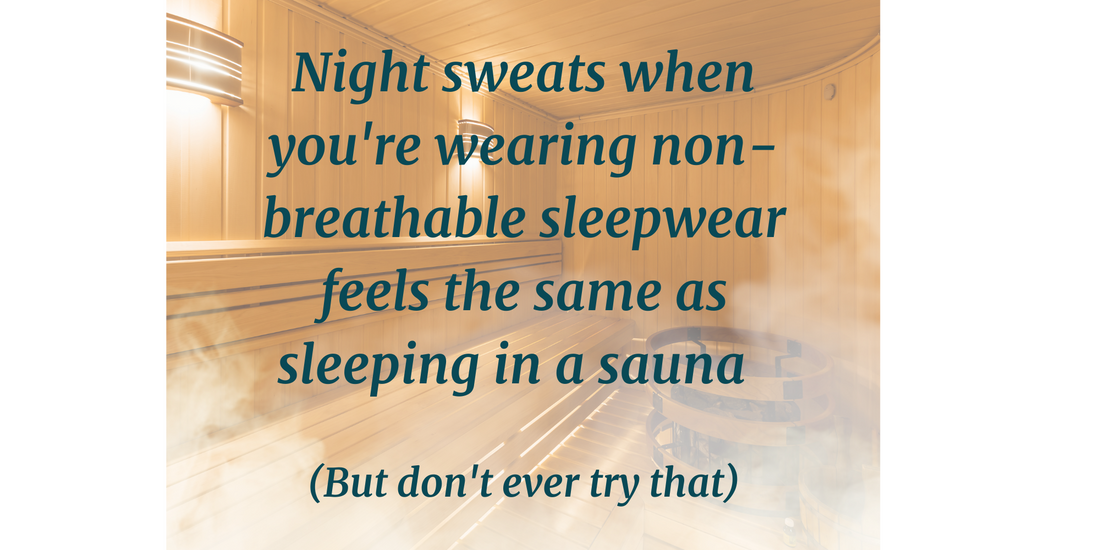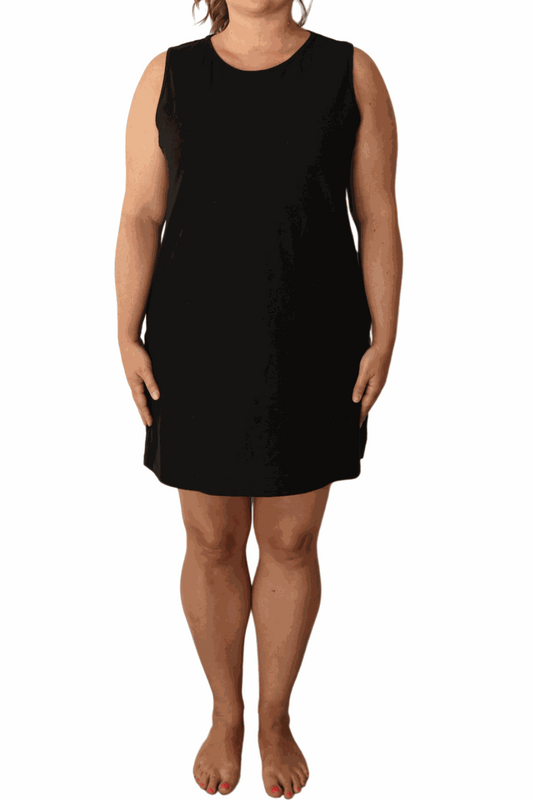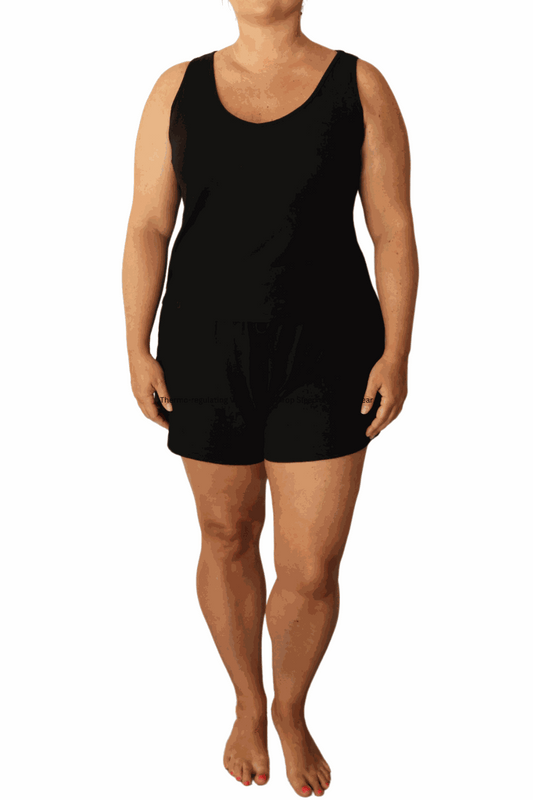
What Not To Sleep In If You Have Night Sweats
Share
(Note: this post was updated on October 29, 2023)
I had been suffering from menopause-related night sweats for well over a year when I finally accepted that they were not going away anytime soon. I had been sleeping in an old polyester nightgown and was flipping my covers on and off all night long. I was soaked and exhausted every morning, and over time, the sleep deprivation really took its toll.
I decided that if I was going to continue to have night sweats, I’d better find the right sleepwear to help keep me comfortable – at the very least dry, and ideally could manage the heat my body was throwing off every other minute. So, I figured the best fabric for my night sweats was cotton. After all, cotton’s a highly breathable, natural fabric. It would help me solve my hot and clammy problem. I bought a new cotton nightgown, and I was excited that that night I would finally sleep again. I went to bed and drifted off to dreamland…for about 4 minutes. Then, the same routine as I’d always gone through started again: covers on…covers off. All. Night. Long.
In the morning I woke up soggy and exhausted and very discouraged. I couldn’t figure out why my breathable, natural nightgown hadn’t kept me dry and comfortable. In fact, after a month of use, I noticed my new nightgown had permanent sweat stains around the chest and under the arms.
It was at that point that I realized that sleeping comfortably with night sweats might be a little more challenging than I had thought. I wondered, if cotton was terrible for night sweats, which other fabrics should I avoid and which ones would help me sleep better and wake up dry?
While I was doing my research, I used my own background writing about green building materials to help me evaluate certain claims that companies were making about their fabrics. I also dug into the technical research papers on fabrics and the tests they performed.
Naturally, the subject is way more complex than I initially thought. It turns out the heat-sweat-fabric interaction involves chemistry, physics and biology. In addition to fabrics made out of specific fibres (ie, cotton or polyester), it also depends on how tightly they're woven, or the thickness of the fibre. Further, some blends are fantastic for night sweats, while others are not so good.
As you’ll see below, there are also some surprising materials you might want to stay away from if you suffer from night sweats. Some are made from natural (animal or plant) sources, whereas those made from synthetic sources, such as polyester or nylon, might be okay in certain cases.
There is one final caveat – you can have the best sleepwear in the world, or no sleepwear at all, and still wake up hot and sweaty and have a terrible night’s sleep. Why? It has to do with your sheets, blankets, mattress cover and mattress. They all interact with your heat-producing body. If they are all well-aligned, you can sleep much more comfortably and may, possibly, be able to sleep through the night again. However, if you are using the wrong materials for those layers, you're probably waking up soaked and exhausted. But, that, my friend, is a whole, ‘nother kettle of fish that we’ll leave for another time.
Right now, here are some of the worst fabrics you can sleep in.
Most Polyester, Nylon, Acrylic, Synthetic fabrics
There are a lot of sleepwear garments made of polyester because it is an inexpensive fabric. It is, however, because it is synthetic, (petroleum-based) the fibres don't respond to heat and moisture changes produced by your body. You can think of polyester and other synthetic fabric like plastic fishing line. The fibre itself is incapable of responding to heat and sweat given off by your body. In fact, tightly woven or thicker polyester can feel and act like plastic food wrap - trapping heat and moisture next to you keeping you very uncomfortable all night long.
The one exception is a polyester garment that is specifically made to wick sweat and pull heat through the sleepwear and moderate your body temperature. The way these synthetic garments work is that they have been treated with some sort of coating to manage heat and sweat, and they are woven/knitted in a way that pulls the heat away from you. But for the most part, ordinary polyester sleepwear will trap all that heat and sweat next to you leaving you hot and clammy all night long. (You can read our post on why we don't use polyester here.)
Cotton
You’ve already read about my own experience with cotton and if you’re suffering with night sweats, you may have used the same logic I did and invested in some cotton sleepwear. The reason it doesn’t work for night sweats is because cotton is highly absorbent but also doesn’t like letting go of the water. Generally, cotton products take much longer to dry than some other fibres.
When you have night sweats and you're wearing a cotton garment, all that sweat your body has produced to cool you down is now trapped in your sleepwear next to your skin. Your sheets and blankets/duvet are also preventing the moisture from going anywhere, making you feel hot and clammy all night long, completely wrecking any chance you had for a decent night's sleep.
In the outdoor community they have a saying: “Cotton is rotten.” As you heat up and cool down, cotton will cling to you and you will become chilled and wet.
Silk
Silk is a wonderful insulating fibre. About 30 years ago, maybe more (am I showing my age??), silk was introduced into long underwear for its insulating capabilities. If your body's internal thermostat is working well, then silk is a lovely fabric, but if your thermostat is wonky and telling your body that you need to cool down every other minute, you’re going to be trapping all that heat and sweat next to you. Silk not only insulates you from outside temperatures, it traps the heat and sweat produced by you making you very hot and uncomfortable.
Silk is also terrible at managing moisture. If you have a silk blouse or camisole or some nice lingerie, think about what happens to it when you sweat. The sweat you produce will degrade the sleepwear much faster than other fabrics.
Wool
Like silk, wool is a great insulator. But unlike silk, it is wonderful at managing moisture. In fact, in houses, wool is becoming a popular choice for insulation because it works well even when wet. So, you would think that it would be great for night sweats.
The problem with wool is that even though it manages moisture really well, keeping you dry, it also keeps all the heat that you generate next to your body. You wake up and have to cover-flip because you’re so hot.
What about Merino wool?
Merino wool is superfine, soft wool and many people with night sweats love it. It is still highly insulating, so if you love the idea of wearing wool at night, make sure you get summer-weight Merino wool sleepwear. Anything heavier and you'll probably find it too hot.
So, if these are fabrics you shouldn’t wear to bed if you have night sweats, which fabrics are okay to wear to bed for night sweats?
What are we looking for in acceptable fabrics?
In order to manage night sweats well, we ideally want a fabric that can wick moisture as quickly as possible. In fact, we want it to manage moisture and heat so quickly that you, the sleeper, avoid being disturbed. That means the fabric needs to respond to heat and moisture actively. Not all fabrics can do that effectively, as we’ve seen. But there are a few that do.
Also, as mentioned, it’s not just the type of fabric, it also depends on the type of weave or knit, and how dense and thick the fabric is. With night sweats, you want to select a light-weight to medium-weight fabric from the right type of fabric. If you choose a great fabric that’s really thick or dense, it will trap the heat next to you so you’ll continue to sleep poorly and stay hot and probably sweaty.
Below is our list of fabrics for sleeping with night sweats, in order from "okay" to "excellent."
Viscose and rayon (acceptable-ish)
Viscose and rayon are two sides of the same coin. They are both cellulose-based semi-synthetic fabrics. What that means is that the substrate, or first ingredient, is some sort of wood or grass-based cellulosic material. The most common cellulose material used is a fast-growing deciduous trees such eucalyptus and beech. Bamboo is another popular choice for turning into rayon. These materials are turned into pulp and chemicals are added. Then the mixture is extruded through spinarets to create the yarn which is then woven together to create rayon or viscose fabric.
In terms of whether or not rayon cools your sweats and manages moisture, it is a breathable fabric and will wick sweat away from you. It has medium heat managing ability, however, and is not as effective as some other fabrics.
Finally, rayon and viscose tend to be more delicate than other choices (see below). Most rayon and viscose sleepwear won’t last very long and are not easily repairable. From a cost perspective, however, they tend to be reasonably priced, making them a good choice for those on a budget. Choose as light a fabric as possible for maximum comfort.
If you're buying bamboo pjs because you've heard they are better for night sweats, you can check out my article on why I don't love bamboo - and neither does the US Federal Trade Commission.

The best fabrics for night sweats
You might be wondering what on earth you can wear to bed with night sweats if you don’t like to sleep in the nude (and most people don’t). Fear not; there are some great fabrics for managing night sweats. They are fast-wicking and manage heat (thermoregulate) so you sleep with a more even temperature throughout the night. That means you wake up less, if at all, and sleep dry and comfortable all night long. The best fabrics have some similar characteristics: they all respond to heat and moisture actively due to their fibre structure (and sometimes, how they are knitted or woven) and two types are very durable so they last a long time.
Linen
Linen is an age-old “workhorse” fabric that not only wicks moisture and manages heat, but is also incredibly strong so it lasts a very long time. A well-made linen garment will last for decades and the longer you wear it, the softer it becomes. The fibre structure is hollow and can wick heat and sweat away from your body quickly, so you stay dry and comfortable and wake up less often. A few drawbacks of linen are that it is not stretchy, it takes a while for high-quality linen to soften, and the upfront cost can be expensive.
Lyocell (Tencel)
Like rayon and viscose, lyocell is a semi-synthetic, cellulose-based fabric. However, unlike rayon and viscose, lyocell is manufactured using fewer chemicals in a closed loop process. Lyocell is the generic term for Tencel – a brand with which you may be more familiar. The fibre processing keeps much of the cellulose-based product intact so that the wearer benefits from the cellulose base’s natural properties. For example, bamboo rayon behaves like any other rayon, whereas bamboo lyocell responds to heat and moisture like bamboo would, actively managing heat and moisture to keep you dry. Some drawbacks to lyocell are that it is expensive, and it can be difficult to find sleepwear made from it, it tears and pills easily and doesn't last as long as hemp or linen.
Hemp
Hemp is similar in texture and properties to linen. It is very strong and, like linen, hemp-based garments can last for decades. If it is processed to be an all-natural product (and not a rayon-based product) it will retain all of its great heat and moisture managing properties. Because it is so strong, it’s best used when blended with other fibres such as cotton or lyocell which will make it soft and supple. In order for the garment to be effective as a blend, the hemp component should be the majority fibre. We make our sleepwear out of a knit or 55% hemp and 45% cotton, and it has allowed many of our clients to sleep through the night again.
If you suffer from night sweats for any reason, choosing the right sleepwear will actually help you sleep more comfortably and may even let you sleep through the night again. If you're suffering from menopause-related night sweats, you can read all about how our sleepwear can help you sleep better.
You might also like:
Beyond Bamboo: The Top Fabrics for Handling Night Sweats
Hot Sleeper, Cold Sleeper, Night Sweats, Your Sleepwear Influences Your Sleep Quality




